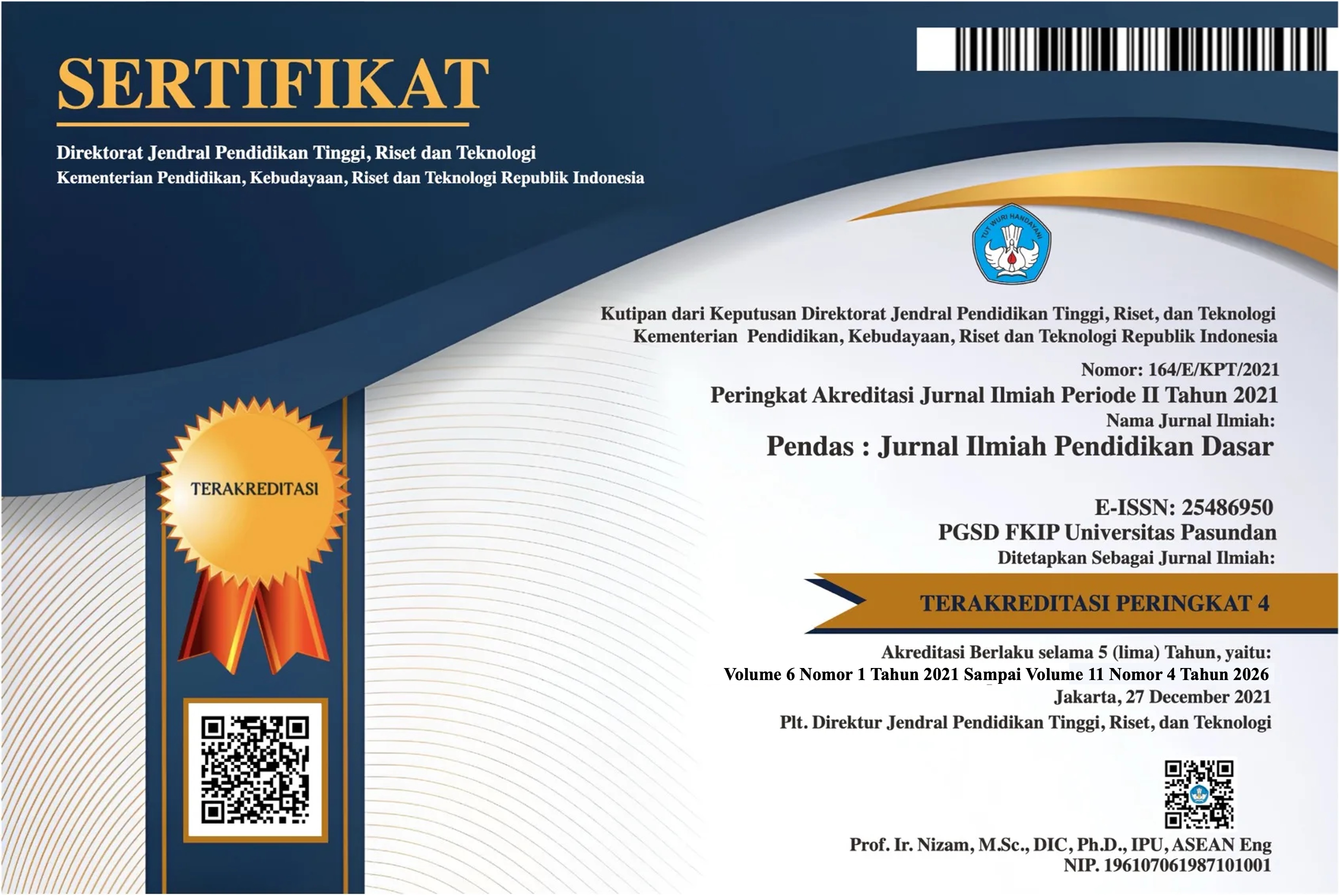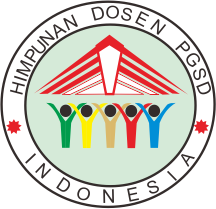PERSPEKTIF CONNECTIVISME TERHADAP PENGGUNAAN MEDIA GAMIFIKASI DALAM PEMBELAJARAN DI SEKOLAH
DOI:
https://doi.org/10.23969/jp.v9i03.15962Keywords:
connectivism perspective, gamification media, learning at schoolAbstract
This study aims to describe the characteristics of Stephen Downes' Connectivism learning theory, the application of gamification media, and the Connectivism perspective on the use of gamification media in learning. This research is a descriptive qualitative study conducted at MI Muhammadiyah Karanganyar. Data collection techniques included observation, interviews, and documentation. The results of this study show that overall, gamification media applications such as Wordwall, Marbel Budaya Nusantara, and Quizizz have proven effective in enhancing engagement, motivation, collaboration, critical thinking skills, and appreciation for local culture. The integration of digital technology in learning through gamification can create a more engaging and productive learning environment for students. The use of gamification aligns with the principles of connectivism, where learning is considered a process that occurs within a network of social interactions and connections with various sources of information.
Downloads
References
Amin, A., Hidayat, R., & Nugroho, A. (2021). Structured Diagrams as Teaching Tools for Complex Concepts in Science Education. Journal of Science Education.
Awaliya, N., dkk. (2018). Budaya Nusantara dan Pendidikan Anak. Jakarta: Penerbit PT. Pustaka Karsa Mandiri.
Bicen, H., & Kocakoyun, S. (2018). Perceptions of students for gamification approach: Kahoot as a case study. International Journal of Emerging Technologies in Learning.
Caponetto, I., Earp, J., & Ott, M. (2018). "Gamification and Education: A Literature Review." Handbook of Research on Serious Games for Educational Applications, 105-125.
Dewi, R. (2018). Marbel: Belajar Sambil Bermain. Jakarta: Penerbit PT. Bentang Pustaka.
Dichev, C., & Dicheva, D. (2017). Gamifying education: what is known, what is believed and what remains uncertain: a critical review. International Journal of Educational Technology in Higher Education, 14(1), 1-36.
Donnelly, S., McGarr, O., & Lynch, R. (2021). Digital storytelling in primary education: A systematic literature review. Computers & Education.
Downes, S. (2008). An Introduction to Connective Knowledge. In T. Hug (Ed.), Media, Knowledge & Education: Exploring new Spaces, Relations and Dynamics in Digital Media Ecologies. Innsbruck: Innsbruck University Press.
Fadilla, D. A., & Nurfadhilah, S. (2022). Penerapan gamification untuk meningkatkan motivasi belajar siswa dalam pembelajaran jarak jauh. Inovasi Kurikulum, 19(1), 34-43.
Gold, C., Voracek, M., & Wigram, T. (2020). Effects of music therapy for children and adolescents with psychopathology: A meta-analysis. Journal of Child Psychology and Psychiatry.
Hainey, T., Connolly, T. M., Boyle, E. A., Wilson, A., & Razak, A. (2016). A systematic literature review of games-based learning empirical evidence in primary education. Computers & Education, 102, 202-223.
Hamari, J., Koivisto, J., & Sarsa, H. (2016). Does gamification work? – A literature review of empirical studies on gamification. Proceedings of the 47th Hawaii International Conference on System Sciences.
Hanus, M. D., & Fox, J. (2015). Assessing the effects of gamification in the classroom: A longitudinal study on intrinsic motivation, social comparison, satisfaction, effort, and academic performance. Computers & Education, 80, 152-161.
Huang, B., & Hew, K. F. (2018). "Implementing a theory-driven gamification model in higher education flipped courses: Effects on out-of-class activity completion and quality of artifacts." Computers & Education, 125, 254-272.
Johnson, L., Adams Becker, S., Estrada, V., & Freeman, A. (2015). NMC Horizon Report: 2015 Higher Education Edition. The New Media Consortium.
Kominfo. (2014). Peran Orang Tua dan Guru dalam Pembiasaan Penggunaan Internet bagi Remaja. Jakarta: Kementerian Komunikasi dan Informatika Republik Indonesia.
Landers, R. N., & Callan, R. C. (2014). Casual social games as serious games: The psychology of gamification in undergraduate education and employee training. In Serious Games and Edutainment Applications (pp. 399-423). Springer.
Lemi Indriyani. (2019). Pemanfaatan Media Pembelajaran Dalam Proses Belajar Untuk Meningkatkan Kemampuan Berpikir Kognitif Peserta Didik. FKIP, Universitas Sultan Ageng Tirtayasa Vol. 2, No. 1, 2019
Lopez, G., Torrente, J., & Moreno-Ger, P. (2019). "Gamification in education: A systematic mapping study." Educational Technology Research and Development, 67(4), 729-763.
Majid, N. A. A., & Foo, S. (2020). Integrating Gamification with Digital Technologies in Education: A Systematic Literature Review. Computers & Education, 151, 103857. https://doi.org/10.1016/j.compedu.2020.103857
Moreno, R., & Mayer, R. E. (2019). Cognitive principles of multimedia learning: The role of modality and contiguity. Journal of Educational Psychology.
Miles, M. B., & Huberman, A. M. (1992). Qualitative Data Analysis: An Expanded Sourcebook (2nd ed.). Thousand Oaks, CA: Sage Publications.
Muntean, C. I. (2011). Raising engagement in e-learning through gamification. Proceedings of the 6th International Conference on Virtual Learning ICVL.
Pradani, T. G. (2022). Penggunaan media pembelajaran wordwall untuk meningkatkan minat dan motivasi belajar peserta didik pada pembelajaran IPA di Sekolah Dasar. Educenter: Jurnal Ilmiah Pendidikan, 1(5), 452–457. https://doi.org/10.55904/educenter.v1i5.162 Rafnis, R. (2019).
Rahman, F., Nugraha, D., & Sari, R. (2019). The Effect of Using Pictures in Teaching Vocabulary to Young Learners. Journal of Education and Learning.
Salsabila, U. H., Habiba, I. S., Amanah, I. L., Istiqomah, N. A., & Difany, S. (2020). Pemanfaatan Aplikasi Quizizz Sebagai Media Pembelajaran Ditengah Pandemi Pada Peserta didik SMA. Jurnal Ilmiah Ilmu Terapan Universitas Jambi|JIITUJ|, 4(2), 163–173. https://doi.org/10.22437/jiituj.v4i2.11605
Sanchez-Mena, A., & Marti-Parreño, J. (2017). "Gamification in higher education: Teachers' reflections on gamified activities." Journal of Teaching and Learning with Technology, 6(1), 89-102.
Shaliha, M. A., & Fakhzikril, M. R. (2022). Pengembangan Konsep Belajar dengan Gamifikasi. Inovasi Kurikulum, 19(1), 79–86. https://doi.org/10.17509/jik.v19i1.43608
Subhash, S., & Cudney, E. A. (2018). "Gamified learning in higher education: A systematic review of the literature." Computers in Human Behavior, 87, 192-206.
Sugiyono. (2022). Metode Penelitian Kuantitatif, Kualitatif, dan R&D. Alfabeta, Bandung.
Supriyono, S. (2018). Pentingnya media pembelajaran untuk meningkatkan minat belajar siswa SD. Edustream: Jurnal Pendidikan Dasar, 2(1), 43-48.
Sutama. (2019). Metode Penelitian Pendidikan (Kuantitatif, Kualitatif, PTK, Mix Method, R&D). Sukoharjo: CV.Jasmine.
Syafii, I., Suyanto, & Haryanto. (2020). Development of Simple Learning Media to Enhance Student Engagement and Learning Outcomes. Journal of Educational Research and Evaluation.
Vlachopoulos, D., & Makri, A. (2019). The effect of games and simulations on higher education: A systematic literature review. International Journal of Educational Technology in Higher Education.
Waryanto. (2006). Pembelajaran Online. Jakarta: Penerbit PT. Gramedia Widiasarana Indonesia.
Yuliani, N., & Hidayat, M. (2018). The Use of Low-Cost Instructional Media in Primary Education: Challenges and Opportunities. Journal of Primary Education.
Downloads
Published
Issue
Section
License
Copyright (c) 2024 Pendas : Jurnal Ilmiah Pendidikan Dasar

This work is licensed under a Creative Commons Attribution 4.0 International License.


















